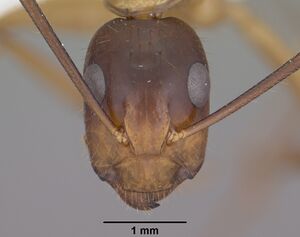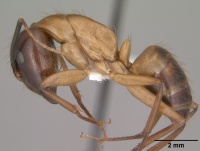Camponotus vafer
| Camponotus vafer | |
|---|---|

| |
| Scientific classification | |
| Kingdom: | Animalia |
| Phylum: | Arthropoda |
| Class: | Insecta |
| Order: | Hymenoptera |
| Family: | Formicidae |
| Subfamily: | Formicinae |
| Tribe: | Camponotini |
| Genus: | Camponotus |
| Species: | C. vafer |
| Binomial name | |
| Camponotus vafer Wheeler, W.M., 1910 | |
Camponotus vafer is arboreal, usually nesting in dead limbs of various oak species. A series of major and minor workers and alate queens in the USNM (Lot. No. 41-11267) was collected at Bisbee, Cochise Co., Ariz., and noted to have been "nesting in woodwork."
Identification
Snelling (2006) - Major workers and queens distinguished from other members of this complex (C. festinatus) by the usually broadly and weakly excised anterior clypeal margin and by the longitudinally microrugose mandible, merging into coarser rugae near teeth; mandible of minor / media workers similar but frequently merely microreticulate for almost its entire length; scape of minor / media with abundant erect long and short setae.
Those samples that seem, in my view, to represent C. vafer are distinguishable from Camponotus festinatus by the following suite of characters: (1) antennal scape of minor workers with numerous erect to suberect setae (as well as some subdecument pubescence) vs. antennal scape lacking erect or suberect setae (rarely 1 or 2 present) in C. festinatus and all pubescence entirely appressed; (2) mandible of major worker dull, distinctly longitudinally microrugose on basal one-third or more, becoming microreticulate toward apex, but with some coarser rugae near teeth; (3) gena, below eye, shiny and weakly microreticulate vs. dull and sharply microreticulate in C. festinatus. Both of these species possess a number of standing setae on the side of the pronotum in the vicinity of the ventral margin, in addition to the usual scattered appressed pubescence.
Distribution
Mexico and United States. In addition to material from the Huachuca Mountains, I have examined Arizona samples from sites in Cochise Co. (Bisbee; Chiricahua Mts.), Pima Co. (Baboquivari Mts.), and Santa Cruz Co. (Pajarito Mts.; Santa Rita Mts.). Camponotus vafer has also been collected in the Peloncillo Mts., Hidalgo Co., New Mexico (MacKay & MacKay 2002). The range of this species undoubtedly includes northwestern Chihuahua and northeastern Sonora, Mexico. (Snelling 2006)
Latitudinal Distribution Pattern
Latitudinal Range: 36.61° to 28.73°.
| North Temperate |
North Subtropical |
Tropical | South Subtropical |
South Temperate |
- Source: AntMaps
Distribution based on Regional Taxon Lists
Nearctic Region: United States (type locality).
Neotropical Region: Mexico.
Distribution based on AntMaps
Distribution based on AntWeb specimens
Check data from AntWeb
Countries Occupied
| Number of countries occupied by this species based on AntWiki Regional Taxon Lists. In general, fewer countries occupied indicates a narrower range, while more countries indicates a more widespread species. |

|
Estimated Abundance
| Relative abundance based on number of AntMaps records per species (this species within the purple bar). Fewer records (to the left) indicates a less abundant/encountered species while more records (to the right) indicates more abundant/encountered species. |

|
Habitat
Appears to be fairly consistent: lower montane forest, a mixture of oak, pine, and juniper.
Biology
Castes
Worker
   
| |
| . | Owned by Museum of Comparative Zoology. |
Images from AntWeb
   
| |
| Worker (major/soldier). Specimen code casent0102787. Photographer Jen Fogarty, uploaded by California Academy of Sciences. | Owned by CAS, San Francisco, CA, USA. |
Nomenclature
The following information is derived from Barry Bolton's Online Catalogue of the Ants of the World.
- vafer. Camponotus vafer Wheeler, W.M. 1910d: 315 (s.w.q.) U.S.A. (Arizona).
- Type-material: syntype major and minor workers (numbers not stated, “numerous….two colonies”), 1 syntype queen.
- Type-localities: workers U.S.A.: Arizona, Huachuca Mts, Palmerlee (5000 & 6000 ft) (C.R. Biederman),
- queen U.S.A.: Arizona, Huachuca Mts (H. Skinner).]
- Type-depositories: LACM, MCZC.
- Combination in C. (Myrmoturba): Forel, 1914a: 268;
- combination in C. (Camponotus): Emery, 1925b: 75;
- combination in C. (Tanaemyrmex): Creighton, 1950a: 381.
- Status as species: Wheeler, W.M. 1917a: 561; Emery, 1925b: 75; Cole, 1937b: 139; Creighton, 1950a: 381; Smith, M.R. 1951a: 843; Hunt & Snelling, 1975: 22; Smith, D.R. 1979: 1430; Bolton, 1995b: 128; Mackay & Mackay, 2002: 309; Snelling, R.R. 2006: 95 (redescription).
- Distribution: Mexico, U.S.A.
Unless otherwise noted the text for the remainder of this section is reported from the publication that includes the original description.
Description
Worker
Snelling (2006) – Major (n=12). Measurements: HL 2.80-3.50; HW 2.55-3.50; EL 0.65-0.75; HFL 2.65-3.25; SL 2.55-3.05; PW 1.65-2.05; ML 3.55-4.70. Indices: CI 91-100; HFI 90-112; OI 21-25; SI 82-93.
Head shape similar to that of Camponotus festinatus. Mandible conspicuously roughened with well defined longitudinal microrugae that merge with coarser rugae near base of mandibular teeth and with abundant coarse elongate punctures. EL 0.45-0.54 × OMD; ICD 0.54-0.63 × HW.
Pilosity about as described for C. festinatus; side of pronotum usually with 1 to several short standing setae near ventral margin. The following numbers of long standing (decumbent to fully erect) setae present on indicated structures: scape shaft (10-14), ventral margin of profemur (6-7), pronotal disc (30-40), mesonotum (12-15), propodeum (8-17), petiole (10-16), disc of gastral tergum 1 (8-16), premarginal band of gastral tergum 1 (20-30).
Media and minor (n=12). Measurements: HL 1.60-2.50; HW 1.05-2.10; EL 0.50-0.60; HFL 2.05-2.95; SL 2.05-2.75; PW 1.00-1.55; ML 2.55-3.75. Indices: CI 66-84; HFI 133-196; OI 24-31; SI 104-131.
Similar to these subcastes of C. festinatus but scape with abundant (usually 15+) erect setae and similar number of shorter setae; EL 0.55 - 0.77 × OMD; ICD 0.61 - 0.67 × HW.
Pilosity about as described for C. festinatus. The following numbers of long standing (decumbent to fully erect) setae present on indicated structures: scape shaft (20-36), ventral margin of profemur (7-8), pronotal disc (10-14), mesonotum (4-10), propodeum (4-11), petiole (6-10), disc of gastral tergum 1 (15-10), premarginal band of gastral tergum 1 (6 - 12).
Queen
Snelling (2006) - (n=3). Measurements: HL 2.80-3.00; HW 2.55-2.80; EL 0.70-0.71; HFL 2.85-2.90; SL 2.65-2.75; PW 2.20-2.45; ML 4.90-5.10. Indices: CI 91-93; HFI 101-114; OI 24-27; SI 90-95.
Similar to queens to C. festinatus but with clypeal and mandibular features noted above, which will also serve to distinguish this from the remaining species in the complex. Outer eye margins failing to attain margins of head; EL 0.54-0.65 × OMD; ICD 0.69-0.71 × HW; IOD 2.87-3.36 and OOD 3.36-4.00 × OD.
Type Material
Snelling (2006) - This species was originally described from specimens collected in the Huachuca Mountains, Cochise Co., Arizona; most of the syntypes are in the Museum of Comparative Zoology; a single major worker syntype is in the Los Angeles County Museum of Natural History.
Wheeler (1910) - Described from numerous workers taken by Mr. C. R. Biederman from two large colonies nesting under stones at Palmerlee, Arizona, (5000 and 6000 ft.) and a single female taken by Dr. H. Skinner in the Huachuca Mts. of the same territory.
Determination Clarifications
Camponotus vafer is most similar to Camponotus festinatus and has been confused with that species. Chreighton (1950) distinguished between the two on the basis of the broad and shallow clypeal excision, the 5- to 6-toothed mandible and the uniformly short gular hairs of C. vafer. MacKay & MacKay (2002) noted that all of these features were inconsistent and unreliable, based on their examination of specimens of C. festinatus from localities ranging from western Texas and northern Mexico to southeastern California. It seems certain that this wide-ranging selection of material included not only true C. festinatus, as here defined, but other species as well; e.g., C. festinatus is not known to occur in California and such samples might be either Camponotus fragilis or Camponotus absquatulator. My own examination of similarly wide-ranging samples revealed the existence of a mix of superficially similar species.
References
- Alatorre-Bracamontes, C.E., Vásquez-Bolaños, M. 2010. Lista comentada de las hormigas (Hymenoptera: Formicidae) del norte de México. Dugesiana 17(1): 9-36.
- Creighton, W. S. 1950a. The ants of North America. Bulletin of the Museum of Comparative Zoology 104: 1-585 (page 381, Combination in C. (Tanaemyrmex))
- Emery, C. 1925d. Hymenoptera. Fam. Formicidae. Subfam. Formicinae. Genera Insectorum 183: 1-302 (page 75, Combination in C. (Camponotus))
- Forel, A. 1914a. Le genre Camponotus Mayr et les genres voisins. Rev. Suisse Zool. 22: 257-276 (page 268, Combination in C. (Myrmoturba))
- Snelling, R. R. 2006. Taxonomy of the Camponotus festinatus complex in the United States of America (Hymenoptera: Formicidae). Myrmecologische Nachrichten. 8:83-97.
- Wheeler, W. M. 1910g. The North American ants of the genus Camponotus Mayr. Ann. N. Y. Acad. Sci. 20: 295-354 (page 315, soldier, worker, queen described)
References based on Global Ant Biodiversity Informatics
- Cover S. P., and R. A. Johnson. 20011. Checklist of Arizona Ants. Downloaded on January 7th at http://www.asu.edu/clas/sirgtools/AZants-2011%20updatev2.pdf
- Dattilo W. et al. 2019. MEXICO ANTS: incidence and abundance along the Nearctic-Neotropical interface. Ecology https://doi.org/10.1002/ecy.2944
- Degnan, P.H., A.B. Lazarus, C.D. Brock and J.J. Wernegreen. 2004. Host-Symbiont Stability and Fast Evolutionary Rates in an Ant-Bacterium Association:Cospeciation of Camponotus Species and Their Endosymbionts, Candidatus Blochmannia. Systematic Biology 53(1):95-110
- Johnson R. Personnal Database. Accessed on February 5th 2014 at http://www.asu.edu/clas/sirgtools/resources.htm
- Longino, J.T. 2010. Personal Communication. Longino Collection Database
- Mackay W. P., and E. E. Mackay. 2002. The ants of New Mexico (Hymenoptera: Formicidae). Lewiston, New York: Edwin Mellen Press, 400 pp.
- Nielsen, M.G. 1986. Respiratory rates of ants from different climatic areas. Journal of Insect Physiology 32(2): 125-131
- O'Keefe S. T., J. L. Cook, T. Dudek, D. F. Wunneburger, M. D. Guzman, R. N. Coulson, and S. B. Vinson. 2000. The Distribution of Texas Ants. The Southwestern Entomologist 22: 1-92.
- Snelling R. R. 2006. Taxonomy of the Camponotus festinatus complex in the United States of America (Hymenoptera: Formicidae). Myrmecologische Nachrichten 8: 83-97
- Vásquez-Bolaños M. 2011. Lista de especies de hormigas (Hymenoptera: Formicidae) para México. Dugesiana 18: 95-133
- Wheeler, G.C. and J. Wheeler. 1985. A checklist of Texas ants. Prairie Naturalist 17:49-64.

